| "Sunlit" Portrait:
(This is my new "Outdoor" Portrait test - read more about it here.)
High resolution and strong detail, though slightly soft. Low contrast adjustment helps a little with the harsh lighting, but not as much as I'd really like. Pretty good color.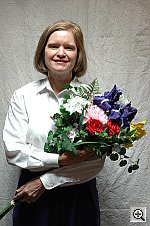
- Exposure compensation: +0.7 EV, about average, although some shooters might prefer the results at +0.3 EV, as it doesn't lose quite as many highlights at that setting.
- Contrast/Tone: High at the default setting, but a bit better with a low contrast adjustment (though highlights are still quite bright). - See my comments below about the contrast adjustment control on the D70S.
- White Balance: Auto is most pleasing, Daylight. Manual setting slightly reddish.
- Color accuracy: Good, though slightly undersaturated, a little dark. Flower bouquet is a little dark, and the blues a bit more purplish than in real life, though the bright reds remain fairly vibrant.
- Skin tones: Slightly pale, but still good.
- Resolution/sharpness: High resolution, though details are a little soft overall. (Digital SLRs like the D70s tend to have very shallow depth of field at a given f-stop, much more so than consumer digicams, and even more so than 35mm film SLRs, due to the very tiny dimensions of the CCD pixels. Here, I had the D70S focusing on Marti's face, so the flowers are quite soft. Judging by the relative sharpness of the background though, it's possible that the camera was back-focusing slightly.)
- Shadow detail: Good, with low noise.
To view the entire exposure series from zero to +1.0 EV, see files D70SOUTLC2AP0.HTM through D70SOUTLC2AP3.HTM on the thumbnail index page.
Contrast Series:
As mentioned above, the D70S' contrast adjustment was a little help here with the deliberately harsh lighting, but I found that it actually had relatively little effect in its settings below the "normal" point, even though it had a very pronounced effect in its higher contrast settings.
Saturation Series:
The color saturation control worked more as I would have expected it to, but I'd really like to have seen five steps covering the same range, rather than the three steps provided.
Effects Series:
I'm normally not a big fan of modes like these on digital cameras, but the "Image Optimization" modes on the D70S actually work very well, to the point that I'd certainly consider using them for the appropriate subjects. In particular, Landscape mode boosts saturation in greens to a pleasing degree, while Portrait mode does a nice job of enhancing Caucasian skin tones (boosting saturation slightly, shifting color slightly toward reds). Finally, "Vivid" is a nice saturation boost, more subtle than that produced by the saturation control itself.
|
|
Closer Portrait: 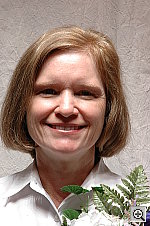
Excellent resolution and detail, but contrast is rather high.
- Exposure compensation: +1.0 EV, a little higher than average.
- Exposure/Tone: High contrast results in harsher skin tones, low-contrast option seems to be of little help.
- Detail: Very strong detail, with better definition and sharpness.
- Distortion: Will depend entirely on the lens in use, none noticeable in this shot, captured with the 18-70mm kit lens at its 70mm setting.
To view the entire exposure series from zero to +1.3 EV, see files D70SOUTFACAP0.HTM through D70SOUTFACAP3.HTM on the thumbnail index page.
|
|
Indoor Portrait, Flash:
Normal Flash, Auto White Balance
+1.0 EV
|
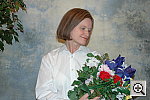 |
Normal Flash, Flash White Balance
+1.0 EV
|
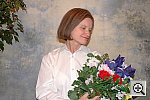 |
Slow-Sync Flash
+0.7 EV
|
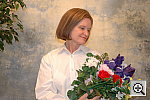 |
Night Portrait Mode
|
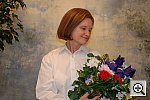 |
Pretty good results with the normal flash mode, though best color with the Flash white balance setting. Slow-Sync mode is slightly brighter, but warmer.
- Exposure: Pretty good at +1.0 EV, though default exposure is only slightly dim. Slow-Sync mode results in slightly brighter exposure, but stronger orange cast at +0.7 EV.
- Flash balance with room lighting?: Generally very good, in that there are no artificial-looking blue highlights from the flash in any of these shots. - Although the flash is powerful enough to swamp the room lighting when the camera isn't in slow sync or Night Portrait mode.
- Color: Rather cool with Auto white balance, a bit too cool for my tastes. Flash white balance resulted in a much more pleasing color. Slow-Sync and Night Portrait modes resulted in stronger warm casts, from the room lighting. In the sample shot with Flash white balance, skin tones are a bit reddish, colors in the bouquet are on the dark side.
To view the entire exposure series from zero to +1.0 EV in the normal flash mode, see files D70SINFFP0.HTM through D70SINFFP3.HTM on the thumbnail index page.
To view the same exposure series in the Slow-Sync flash mode, see files D70INFSAP0.HTM through D70SINFSAP3.HTM on the thumbnail index page.
|
|
Indoor Portrait, No Flash:
|
Auto White Balance
|
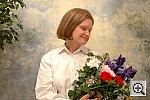 |
|
Incandescent White Balance
|
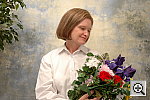 |
|
Manual White Balance
|
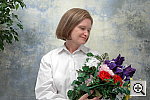 |
Auto white balance has trouble, Manual white balance setting produces very nice color, just slightly cool. Higher than average exposure compensation required.
- Exposure: +1.7 EV adjustment needed, higher than average.
- White Balance: Manual setting best, though slightly cool. Incandescent and Auto settings both warm.
- Color: Skin tones are just a little pink with Manual white balance, though blue flowers are very purple. Red flowers a little hot. (Pretty good, given the very difficult light source.)
ISO Series:
The D70S generally shows low image noise, but as always, the key is how high-ISO images appear when printed at various sizes. As is the case with most digital SLRs, high-ISO images from the D70S can be printed at much larger sizes than those from consumer-level digital cameras at the same ISO. Judging from 8x10 inch prints made on the Canon i9900 printer in our studio, noise really didn't become an issue until ISO 1600, and even there I suspect that a majority of users would find the resulting prints entirely acceptable for framed display on a table or wall. If the images are likely to be scrutinized up close, ISO 800 will probably be about the limit for an 8x10 print. Bottom line, a camera that you can blithely use up to ISO 800, and in many cases ISO 1600, without worrying overmuch about noise.
|
|
House Shot:
|
Auto White Balance
|
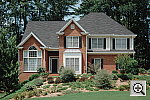 |
|
Daylight White Balance
|
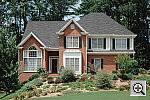 |
|
Manual White Balance
|
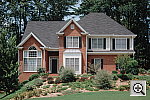 |
Accurate color, with high resolution and strong detail.
- Sharpness/Detail: Very good, strong detail throughout the frame.
- Sharpness in Corners: Excellent. (This and other studio shots captured with a Nikkor 105mm f/2.8 lens though, not the kit lens.)
- Color: Good color with all three white balance settings, though Auto is most pleasing. Manual slightly magenta and Daylight slightly warm, but both still very good.
- Detail lost to anti-noise processing?: Very little, barely noticeable in the shadowed brick patterns.
|
|
Far-Field Test 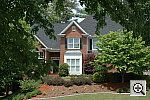
High resolution and strong detail, with a good dynamic range.
This image is shot at infinity to test far-field lens performance, and to present a near-infinite range of detail to the camera. NOTE that this image cannot be directly compared to the other "house" shot, which is a poster, shot in the studio.
- Sharpness/Detail: Very good, a lot of visible fine detail.
- Sharpness in Corners: Excellent (though performance here depends on the lens).
- Color: Very good.
- Dynamic Range: Good, only slight loss of detail in highlights and shadows.
- Detail lost to anti-noise processing?: None noticeable.
Resolution Series:
ISO Series:
As before, excellent noise performance. ISO 1600 is quite usable for a lot of less-critical work, where you don't need to output the images at large sizes. What this series of shots makes clear is the extent of the tradeoff that's being made by the camera between subject detail and image noise: Shots at ISO 800 and 1600 are noticeably softer than those at ISO 200, although the noise is kept very well in check by making this tradeoff.
Sharpness Series:
The D70S' in-camera sharpening options provide a useful range of adjustment. The default sharpening setting does a pretty good job of balancing sharpening against artifacts, although you can (as usual) do better with Photoshop(tm). The highest sharpening setting gives a rather harsh look to the images, but would be suitable for inkjet prints output at smaller sizes (say, 5x7 inches and below). The lowest sharpening setting produces images that take strong/tight unsharp masking in Photoshop very well. (Try 0.3 pixel radius, 200-250%).
Contrast Series:
The D70S' contrast adjustment seems to affect shadow levels much more than highlights, and in this series can be seen to also have a significant affect on color saturation. (An undesirable side-effect, ideally the contrast control would have no impact on color saturation.)
Saturation Series:
Again, a good range of saturation adjustment, but I'd really like to see five steps covering the range, rather than the three provided. Also, there is some minor impact on image contrast here, a bit more than I'd like.
Effects Series:
Again, a useful range of effects through the "Optimization" menu option. I don't personally care for the "Sharp" and "Soft" options, much preferring the control offered by the separate sharpening adjustment. As noted earlier though, Landscape, Portrait, and Vivid options offer very nice/useful color tweaks for certain subjects.
|
|
Lens Zoom Range
The D70S accommodates a wide range of Nikkor lenses, so performance here will vary with the lens in use. The shots below were taken with the 18-70mm "Kit" lens that many users will get along with their D70S. It offers a good range of focal lengths, from a pretty wide angle to a medium-short telephoto (equivalent to a range of 27 - 105mm on a 35mm film camera).
|
|
Musicians Poster
|
Auto White Balance
|
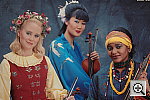 |
|
Daylight White Balance
|
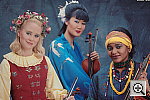 |
|
Manual White Balance
|
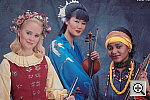 |
Pretty good color, though a hint warm, with excellent detail.
- White Balance: Though just a tad bit warm, Daylight setting best overall. Auto good, but a little too warm, and Manual a little too cool an magenta.
- Color: Overall color slightly dark, but still good skin tones. Blue robe and background a hint greenish, but overall color pretty good.
- Sharpness/Detail: Excellent. (Pushing the limits of the poster though.)
|
|
Macro Shot
Performance here will be entirely a function of the lens in use.
|
|
"Davebox" Test Target
|
Auto White Balance
|
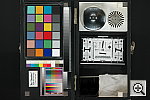 |
|
Daylight White Balance
|
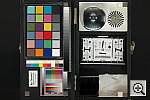 |
|
Manual White Balance
|
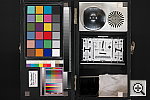 |
Slightly dim exposure, but pretty good color (despite being a bit dark).
- White balance: Best results with the Auto setting, though Daylight and Manual settings performed well also.
- Color Accuracy: The D70S really likes strong reds, as evidenced by the very high saturation of the red , magenta, and pink swatches here. Yellow, yellow-green, and bright green are all slightly undersaturated, while other colors are all quite accurate. Landscape mode brightens the greens a fair bit (bringing them about up to their technically correct saturation levels), while saturation in blues is jacked up considerably. Good (but not exceptional) color overall.
- Shadow detail and noise: Excellent detail, with low noise.
Now, for the REAL technoids, Imatest!
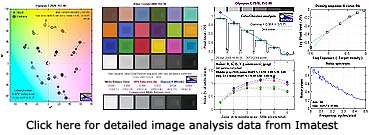
I've recently begun using Norman Koren's excellent "Imatest" analysis program for quantitative, thoroughly objective analysis of digicam test images. I've now also begun measuring dynamic range, as determined by Imatest and a Stouffer 4110 density scale, and this information is included on my Imatest analysis page as well.
The images series below duplicate examples of various camera controls we've already covered above. I include them here though, for our more analytically-minded readers, who'd like to see the effect of various camera controls with a well-known target like the MacBeth Color Checker (tm).
ISO Series:
Contrast Series:
Saturation Series:
Color Series:
Effects Series:
|
|
Low-Light Tests
Very good low-light performance, with reasonable noise levels even at 800 and 1,600 ISO settings. Autofocus system works to a bit darker than 1/16 foot-candle (even with the AF-assist light turned off), way more than sufficient for average city night scenes.
- Exposure limit: 1/16 foot-candle at all ISOs. (About 1/16 as bright as typical city street lighting at night.)
- Autofocus Limit: As dark as 1/16 foot-candle.
- White Balance: Some pink and some warm toned images.
- Noise Levels: Noise is higher at ISO 1,600, but still fairly good, considering. Noise reduction seems to mainly eliminate red pixels, but actual noise level appears about the same.
- Detail loss to anti-noise processing?: Minimal at one foot-candle, but more noticeable at 1/16 foot-candle.
- General Notes: The Nikon D70S' low-light performance is quite good, with good exposures and good noise levels (relatively speaking) at all ISO settings all the way down to the 1/16 foot-candle limit of our test. (About 4 stops darker than typical city night scenes.) Most impressively, its autofocus system worked well all the way down to 1/16 foot-candle, even with the AF-assist illuminator turned off. Bottom line, the D70S is a very competent low-light shooter.
(Note: If you'd like to use a light meter to check light levels for subjects you might be interested in shooting, a light level of one foot-candle corresponds to a normal exposure of two seconds at f/2.8 and ISO 100.)
| |
1 fc
11 lux |
1/2 fc
5.5 lux |
1/4 fc
2.7 lux |
1/8 fc
1.3 lux |
1/16 fc
0.67 lux |
1/16fc
No NR |
ISO
200 |

1 sec
f3.0 |

2 sec
f3.0 |

5 sec
f3.0 |

10 sec
f3.0 |

15 sec
f3.0 |

15 sec
f3.0 |
ISO
400 |

1/2 sec
f3.0 |

1 sec
f3.0 |

2.5 sec
f3.0 |

5 sec
f3.0 |

8 sec
f3.0 |

8 sec
f3.0 |
ISO
800 |

1/4 sec
f3.0 |

1/2 sec
f3.0 |

1.3 sec
f3.0 |

2.5 sec
f3.0 |

4 sec
f3.0 |

4 sec
f3.0 |
ISO
1600 |

1/8 sec
f3.0 |

1/4 sec
f3.0 |

1/1 sec
f3.0 |

1.3 sec
f3.0 |

2 sec
f3.0 |

2 sec
f3.0 |
|
|
Flash Range Test
Bright at eight feet, with about the same brightness level to 14 feet.
- Flash range at telephoto lens setting: 14 feet+.
| 8 ft |
9 ft |
10 ft |
11 ft |
12 ft |
13 ft |
14 ft |

1/60 sec
f4.5 |

1/60 sec
f4.5 |

1/60 sec
f4.5 |

1/60 sec
f4.5 |

1/60 sec
f4.5 |

1/60 sec
f4.5 |

1/60 sec
f4.5 |
|
|
ISO-12233 (WG-18) Resolution Test 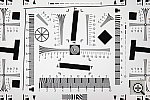
Good resolution, ~1,400 lines of "strong detail."
- Resolution: 1,400 lines horizontally, and about 1,350 lines vertically. (Some reviewers may argue for higher numbers, but I tend to be a bit more conservative than in these ratings than some others.)
- Artifacts begin at: ~1,200 lines.
- Extinction point: ~1,800 lines.
- Barrel/Pincushion distortion: None here, will depend on the lens in use. (The main shot above captured with the Micro Nikkor 105mm f/2.8, which is virtually distortion free.)
- Chromatic Aberration: N/A - see above.
- Corner Sharpness: N/A - see above.
Resolution Series, 105mm f/2.8 Micro Nikkor
Sharpness Series:
|
Viewfinder Accuracy/Flash Uniformity
A very accurate digital SLR.
- Optical Viewfinder Accuracy: Very good, 97.5 percent accuracy. (Better than average for SLRs, most of which come in right around 95% accurate.)
- LCD Viewfinder Accuracy: N/A, LCD for image and menu review only.
- Flash Uniformity: No falloff noticeable. (But this was shot with a telephoto lens.)
|

Follow Imaging Resource: